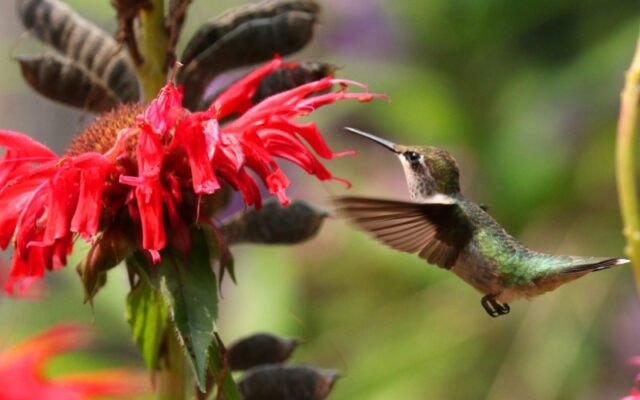
It’s time to welcome back the female hummingbirds to your feeders
By Bob Duchesne
It takes a lot of work to make a hummingbird. Small wonder that you haven’t seen the females very much this summer. But that should all be changing right about now.
Ruby-throated hummingbirds are fast and agile. They can fly up to 25 miles per hour, yet stop on a dime. They can zip upward, downward and sideways. While some birds are able to hover, only hummingbirds can fly backward. They are able to fly 500 miles nonstop across the Gulf of Mexico.
Let’s face it, if you’re a baby hummingbird, you’d better be pretty well developed before you get off the nest.
Furthermore, the males play no role in raising the young’uns. They rush back in spring, arriving well before the ladies, looking to set up and vigorously defend a territory. Their courtship displays are energetic, and they’ll put on a show for as many females as wander through. By the end of mating season, they’re tuckered out.
Thus, the female is stuck with sole responsibility for building the nest. This takes her 6 to 10 days. Next, she lays an average of two eggs. Incubation takes another 10 to 14 days, during which she leaves the nest to feed for only about five minutes every hour.
The chicks hatch blind and featherless. It can take up to a month before they’re ready to leave the nest. Even then, mom still has to feed them for another few days — a porridge of regurgitated nectar, pollen and insects. The chicks need the insect protein to develop. She needs the nectar for energy. During all this time, she barely leaves her small territory. Through the first half of summer, you don’t see her much.
Then you do. After a summer of wondering where your hummingbirds went, there they are. The feeder is suddenly busy. The lone male that claimed it as his own, defending it aggressively, is now overwhelmed by intruders. He gives up. Multiple hummers visit.
Your mileage may vary. Hummingbirds are not dependent on feeders, and they require other nutrients besides sugar water. They catch mosquitoes, gnats, fruit flies and other flying insects in mid-air. They pull trapped bugs out of spider webs, and glean small caterpillars from leaves. They often visit the holes made by sapsuckers to pick insects from the oozing sap.
Weather can have a big impact on feeder visitation. In a warm summer with lots of flowers and insects, they may ignore feeders altogether. In cool, wet weather, they may visit more often. And, of course, your hummers may prefer your neighbor’s flowers, ignoring yours. Every year is different.
There are roughly 325 hummingbird species on the planet, all of them in the New World, most of them in the tropics. The length and curvature of the bill for each species is specialized for feeding on the particular blooms in their home regions. Some hummingbirds are larger than sparrows. Cuba’s bee hummingbird is the smallest bird in the world.
Eight species breed in the United States, though a few others visit. Ruby-throated hummingbirds are the only nesting hummers in the east, but they have the largest range of any North American hummingbird. Their bills are best suited for tubular-shaped blossoms, and they are particularly fond of monarda, also known as bee balm.
“Live fast, die young” could be the motto for our hummingbirds. Their hearts beat about 50 times per second — up to four times faster for a displaying male. Their average lifespan is only about three years. The oldest known banded bird was 9 years old when she was recaptured. Ruby-throated hummingbirds winter throughout Central America, necessitating a long migration twice a year. They’re bold around bigger birds, except that larger hummingbird species tend to push them around. Rufous hummingbirds sometimes wander east, and they’re known to bully ruby-throated hummingbirds.
Bird populations have been declining generally across the country, mostly due to habitat loss. Not so for hummingbirds. Their numbers have slowly increased, thanks to our fondness for planting flowers and erecting feeders.
Just remember three things. First, avoid food dye. The red color in some commercial products is unnecessary, and can be harmful. Four parts water to one part sugar is sufficient.
Second, clean the feeders often. Mold can build up quickly in midsummer, and the nectar can ferment. I use small feeders that empty quickly, just to force myself to wash them at every filling.
Third, hummingbirds are clever about most predators, but they can be clueless about cats. Make sure feeders are placed where cats can’t hide.